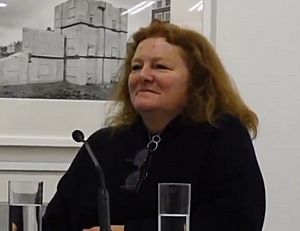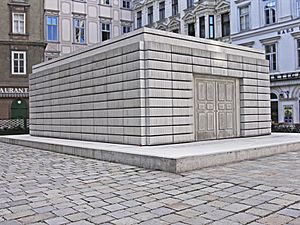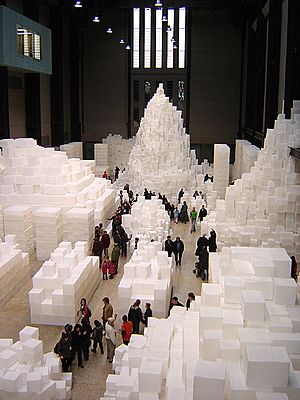Rachel Whiteread facts for kids
Quick facts for kids
Rachel Whiteread
|
|
|---|---|

Rachel Whiteread, 2018
|
|
| Born | 20 April 1963 |
| Nationality | English |
| Education |
|
| Known for | Sculpture, Installation art |
|
Notable work
|
|
| Movement | Young British Artists |
| Awards |
|
| Patron(s) | Environmental Justice Foundation |
Dame Rachel Whiteread (born 20 April 1963) is a famous English artist. She mostly creates sculptures by making "casts" of things. She was the first woman to win the important Turner Prize art award in 1993.
Rachel was part of a group called the Young British Artists. Their work was shown in a big exhibition called Sensation in 1997. Some of her most famous artworks include House, which is a concrete cast of the inside of a whole Victorian house. She also created the Judenplatz Holocaust Memorial in Vienna, which looks like library shelves with the book pages facing outwards. Another well-known piece is Untitled Monument, a sculpture made of resin for the empty fourth plinth in London's Trafalgar Square.
She received special honors from the British Empire. She was made a Commander (CBE) in 2006 and a Dame Commander (DBE) in 2019 for her contributions to art.
Contents
Rachel Whiteread's Early Life and Training
Rachel Whiteread was born in 1963 in Ilford, England. Her mother, Patricia Whiteread, was also an artist. Her father, Thomas Whiteread, was a geography teacher. He passed away when Rachel was studying art in 1988. Rachel is the youngest of three sisters. Her two older sisters are identical twins.
Rachel learned about making casts from sculptor Richard Wilson. She realized how many possibilities there were in casting objects. She studied sculpture at the Slade School of Art in London from 1985 to 1987. She earned her master's degree in 1987. After graduating, she worked at the Serpentine Gallery.
For a while, she worked at Highgate Cemetery, fixing old coffins. She started showing her art in 1987. Her first solo art show was in 1988. Today, she lives and works in a former synagogue in east London with her partner, Marcus Taylor, who is also a sculptor. They have two sons.
How Rachel Whiteread Creates Art
Many of Rachel Whiteread's sculptures are casts of everyday objects. She often casts the "negative space" around or inside things. For example, she is known for making solid casts of the empty space inside furniture like tables and chairs. She also casts architectural details, and even entire rooms or buildings. She believes these casts hold "the memory of years and years of use." Rachel mainly focuses on the shape and form of her pieces.
While still at art school, Rachel cast household items. She created her first sculpture, Closet. It was a plaster cast of the inside of a wooden wardrobe, covered with black felt. This piece was inspired by comforting childhood memories of hiding in a dark closet. After graduating, she rented a studio space. She created Shallow Breath (1988), which was a cast of the underside of a bed. This was made soon after her father passed away. Both sculptures were shown in her first solo exhibition in 1988, along with other casts of home items. All her early works sold, which helped her get funding for bigger sculptures.
Ghost (1990)
After her first show, Rachel decided to cast the empty space that objects could fill. She applied for grants, describing her idea as "mummifying the air in a room." She finished Ghost in 1990. This sculpture was cast from a room in a house in north London, similar to her childhood home. The house was going to be torn down for a road widening project. She used plaster to cast the walls and ceiling of the living room in pieces. Then, she put them together on a metal frame.
Ghost was first shown at the Chisenhale Gallery. It was bought by Charles Saatchi and included in his "Young British Art" show in 1992. In 2004, a fire destroyed many artworks from the Saatchi collection. However, Ghost had been moved and was safe. The National Gallery of Art in Washington, D.C., bought the artwork in 2004. The National Gallery says Rachel "defines the space between positives and negatives, public and private, and manufactured and handmade objects, always with clarity, intelligence, beauty, and power."
House (1993) and the Turner Prize
In October 1993, Rachel Whiteread completed House. This was a cast of a Victorian terraced house. She had thought about casting a whole house since 1991. She and James Lingwood from Artangel looked for houses to be demolished in London. While in Berlin in 1992 and 1993, she created Untitled (Room). This was a cast of a simple, unnamed room that she built herself. She finished the inside of a room-sized box with wallpaper, windows, and a door before casting it. This sculpture is now in the Museum of Modern Art in New York.
House is perhaps her most famous work. It was a concrete cast of the inside of an entire Victorian terraced house. It was shown at the actual location of the original house in East London. All the other houses on that street had already been knocked down. The artwork received mixed reactions. It won her the Turner Prize in 1993 for the best young British artist. But it also won the K Foundation art award for the worst British artist. Rachel was the first woman to win a Turner Prize. The local council decided to demolish House on 11 January 1994, which caused some debate.
Untitled (One Hundred Spaces) (1997)
For the Sensation exhibition in 1997, Rachel Whiteread showed Untitled (One Hundred Spaces). This artwork is a series of resin casts of the empty space underneath chairs.
One art critic described it: "like a field of large glace sweets, it is her most spectacular, and benign installation to date [...] Monuments to domesticity, they are like solidified jellies, opalescent ice-cubes, or bars of soap – lavender, rose, spearmint, lilac. They look like a regulated graveyard or a series of futuristic standing stones with a passing resemblance to television sets."
Water Tower (1998)
In 1998, Rachel Whiteread created Water Tower for New York City's Public Art Fund. This piece, which is about 12 feet tall and 9 feet wide, was a clear resin cast of a water tower. It was placed on a rooftop in New York City's SoHo area. People called it "an extremely beautiful object, which changes colour with the sky, and also a very appropriate one, celebrating one of the most idiosyncratic and charming features of the New York skyline." The artwork is now part of the permanent collection at the Museum of Modern Art (MoMA). Just as Ghost led to the larger House, Water Tower led to her more public work in Trafalgar Square a few years later.
Holocaust Monument (2000)
During the Holocaust, 65,000 Austrian Jewish people were killed. To remember them, a monument was proposed. Simon Wiesenthal suggested a new memorial to the mayor of Vienna. The memorial had to represent all 65,000 lives and the camps where they were killed. Rachel Whiteread was chosen from ten artists to create this monument. Her monument, sometimes called Nameless Library, was built in Judenplatz Square in Vienna. It looks like an inside-out library. This structure was made from concrete casts of books, with their spines facing inwards.
The fact that you cannot read these books suggests the lost lives of the 65,000 Austrian Jews whose stories can no longer be told. This leaves viewers with a feeling of loss. These books have also been seen as a reference to the Nazi book burnings. The sculpture also has no corners or bookshelves, which further symbolizes a lack of structure and support.
Nameless Library was built on the site of Vienna's oldest synagogues. This caused some criticism, as many people felt the original site was enough for the memorial. Some critics even said she was stereotyping Jewish people as "the people of the book." This monument also makes people think about the ideas of inside and outside in architecture.
Untitled Monument (2001)
With Untitled Monument (2001), Rachel Whiteread became the third artist to create a sculpture for the empty Fourth plinth in Trafalgar Square. Her sculpture was an 11-ton resin cast of the plinth itself. It stood upside down, creating a mirror image of the plinth. It was said to be the largest object ever made from resin. It took eight tries to make because the resin kept cracking.
The artwork was made in two halves. Any bubbles on the surface were fixed by filling the small holes with resin. Rachel raised money for this public artwork herself by selling small models of it. This was a big effort, as the mold alone cost over £100,000, and the total cost was about £225,000.
One art critic said: "This dazzling anti-monument monument looks like a glass coffin, but its watery transparency relates to the large fountain that dominates the Trafalgar plaza. Following the aquatic theme, Whiteread's Monument evokes the scene of the 1805 naval battle for which the square is named."
Embankment (2005–2006)
In 2004, Rachel was asked to create a piece for Tate Modern's huge Turbine Hall. She took several months to accept, making sure she could come up with an idea that would fill the space. Her work Embankment was installed in late 2005 and opened to the public on 10 October.
It is made of about 14,000 clear, white polyethylene boxes. These boxes are casts of the inside of cardboard boxes. They are stacked in different ways, some in very tall, mountain-like peaks and others in lower, rectangular arrangements. They are held in place with glue. Rachel mentioned the end scenes of the movies Raiders of the Lost Ark and Citizen Kane as visual inspirations. She also spoke about her mother's death and a time when she had to pack and move many similar boxes.
It is also thought that her trip to the Arctic inspired the work. However, critics point out that white is just the natural color of the polyethylene, and dyeing them would have cost much more. The boxes were made from casts of ten plain cardboard boxes by a company that makes grit bins and traffic bollards.
One art critic wrote: "Everything feels surprisingly domestic in scale, the intimidating vistas of the Turbine Hall shrunk down to irregular paths and byways. From atop the walkway, it looks like a storage depot that is steadily losing the plot; from inside, as you thread your way between the mounds of blocks, it feels more like an icy maze."
Charity Box (2007)
Rachel Whiteread created this small plaster sculpture for a charity auction. It was to support the Prior Weston primary school in Islington, London.
The piece is quite small, measuring about 16 cm x 11.5 cm x 11.5 cm.
The Gran Boathouse (2010)
The Gran Boathouse is located by the water in Gran, Norway. From far away, it looks like a normal boathouse. But when you get closer, you see it is a concrete artwork. The work is a cast of the inside of an old boathouse. Rachel Whiteread turns the boathouse inside out, capturing a moment in time. She wants us to think about what we see around us. Rachel Whiteread said, "I have mummified the air inside the boathouse. I wanted to make a shy sculpture, a sculpture that would stand there peaceful and noble." The boathouse and its interior had all the qualities she was looking for. It represented the history of the place. The sculpture preserves something that would have otherwise been lost.
Rachel Whiteread Drawings (2010)
The Hammer Museum showed Rachel Whiteread's first museum exhibition of her drawings in 2010. This exhibition also traveled to the Nasher Sculpture Center and the Tate Britain.
Recent Artworks (Since 2012)
Rachel Whiteread has continued to create new works. Detached 1, Detached 2, and Detached 3 (2012) are casts of wooden sheds. They show the empty inside of a garden shed in concrete and steel. Circa 1665 (I) (2012), LOOK, LOOK, LOOK (2012), and Loom (2012) are part of a series. These are casts of doors and windows made from resin in shades of rose, light green, or steel gray. When placed against walls, these sculptures glow with light.
Other works like Untitled (Amber) (2012) and Untitled (Green) (2012) are small cardboard creations. They are mounted on notepaper with graphite marks. They are painted with silver leaf and have clear "windows" that look like her resin sculptures.
Cabin (2016)
Cabin is a concrete cast of the inside of a wooden shed. It has been located on Discovery Hill on Governors Island in New York Harbor since 2016. Rachel Whiteread uses this idea to create a "negative space" that once existed but is no longer there. Since Cabin is away from the noisy city, it creates a peaceful and quiet feeling. Cabin is her first public artwork in the United States that is permanently installed on the island.
With this work, Rachel wanted to "blur the idea of space even further." She wanted the park's booming nature to "hide the installation." So, even though the city is very modern and busy, "nature is still present."
Rachel Whiteread stated: "What an extraordinary site, and what an honor to be asked to put something there. I tried to imagine what one could sit there with some kind of dignity, to create a place of remembrance." She wanted "to make a piece that was evocative without wanting to make a memorial to the World Trade Center."
Other Projects
In 2023, Rachel Whiteread created a 31-foot-tall Christmas tree. It was covered by 102 circular neon white hoops. This tree was for Carlos Place outside The Connaught hotel in London's Mayfair district, which asked her to create the piece.
See also
 In Spanish: Rachel Whiteread para niños
In Spanish: Rachel Whiteread para niños



